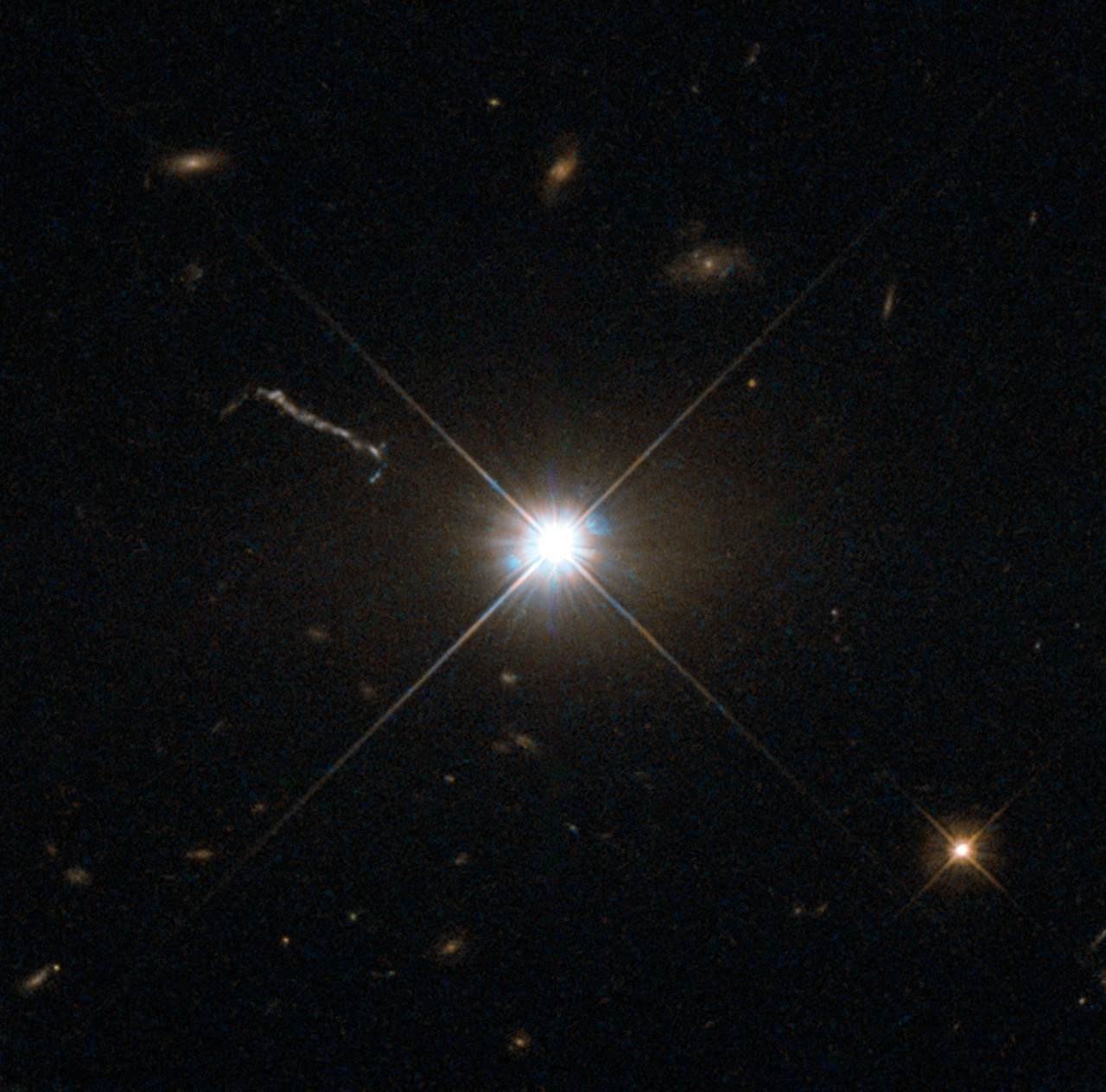Nov 30 2018
The structure of rapidly moving gas surrounding the central super-massive black hole of the quasar 3C 273 has been revealed by extensive observations of the quasar using the GRAVITY instrument. This is the first time the so-called “broad line region” could be resolved.
 Powerhouse in space: The quasar 3C273 resides in a giant elliptical galaxy in the constellation of Virgo at a distance of about 2.5 billion lightyears. It was the first quasar ever to be identified. (Image credit: ESA/Hubble and NASA)
Powerhouse in space: The quasar 3C273 resides in a giant elliptical galaxy in the constellation of Virgo at a distance of about 2.5 billion lightyears. It was the first quasar ever to be identified. (Image credit: ESA/Hubble and NASA)
The international group of astronomers could thus measure the mass of the black hole with unmatched precision. This measurement validates the basic assumptions of the most commonly used technique for measuring the mass of central black holes in distant quasars. It is essential to study these black holes and determine their masses to gain insights into the evolution of the galaxy in general.
More than five decades back, Maarten Schmidt, an astronomer, identified the first “quasi-stellar object” or quasar, called 3C 273, as an exceptionally bright yet distant object. The energy liberated by such a quasar is considerably more than in a normal galaxy such as the Milky Way and cannot be generated through regular fusion processes in stars. Rather, astronomers believe that gravitational energy is transformed into heat when material is swallowed by an extremely massive black hole.
At present, the astronomers have used the GRAVITY instrument to have a detailed look into the heart of the quasar and could actually observe the structure of rapidly moving gas surrounding the central black hole. To date, observations such as these were not possible due to the small angular size of this inner region, which is analogous the size of the Solar system yet at a distance of some 2.5 billion light-years. The GRAVITY instrument integrates all four ESO VLT telescopes through a technology known as interferometry, which enables a huge gain in angular resolution, comparable to a telescope with a diameter of 130 m. Thus, the astronomers will be in a position to unravel structures at the level of 10 micro-arcseconds, corresponding to nearly 0.1 light-years at the distance of the quasar (or an object the size of a 1-Euro-coin on the Moon).
GRAVITY allowed us to resolve the so-called ‘broad line region’ for the first time ever, and to observe the motion of gas clouds around the central black hole. Our observations reveal that the gas clouds do whirl around the central black hole.
Eckhard Sturm, Study Lead Author, Max Planck Institute for Extraterrestrial Physics.
Being an observational feature of quasars, the broad atomic emission lines distinctly indicate the extra-galactic origin of the source. To date, a method known as “reverberation mapping” has been primarily used to measure the size of the broad line region. Changes in the brightness of the quasar’s central engine lead to a light echo when the radiation hits clouds further out—the larger the system’s size, the later the echo. In the most ideal cases, it is also possible to identify the motions of the gas, usually signifying a disk in rotation. Currently, this outcome, inferred from timing information, can be confronted with spatially resolved observations using GRAVITY.
Our results support the fundamental assumptions of reverberation mapping. Information about the motion and size of the region immediately around the black hole are crucial to measure its mass.
Jason Dexter, Study Co-Lead Author, Max Planck Institute for Extraterrestrial Physics.
For the first time, the method has now been experimentally investigated and has successfully passed its test, confirming earlier mass estimates of nearly 300 million solar masses for the black hole. Thus, GRAVITY offers a confirmation of not just the main method applied earlier to determine black hole masses in quasars but also a new, independent, and highly accurate method for measuring such masses. Thus, it promises to offer a benchmark to measure black hole masses in thousands of other quasars.
Quasars have an underlying role in the history of the Universe, as their evolution has intricate connections to the growth of the galaxy. Although astronomers are of the notion that fundamentally all large galaxies accommodate a massive black hole at their center, thus far, only the one in the Milky Way galaxy has been accessible for in-depth studies.
This is the first time that we can spatially resolve and study the immediate environs of a massive black hole outside our home galaxy, the Milky Way. Black holes are intriguing objects, allowing us to probe physics under extreme conditions—and with GRAVITY we can now probe them both near and far.
Reinhard Genzel, Head, Infrared Research Group, Max Planck Institute for Extraterrestrial Physics.